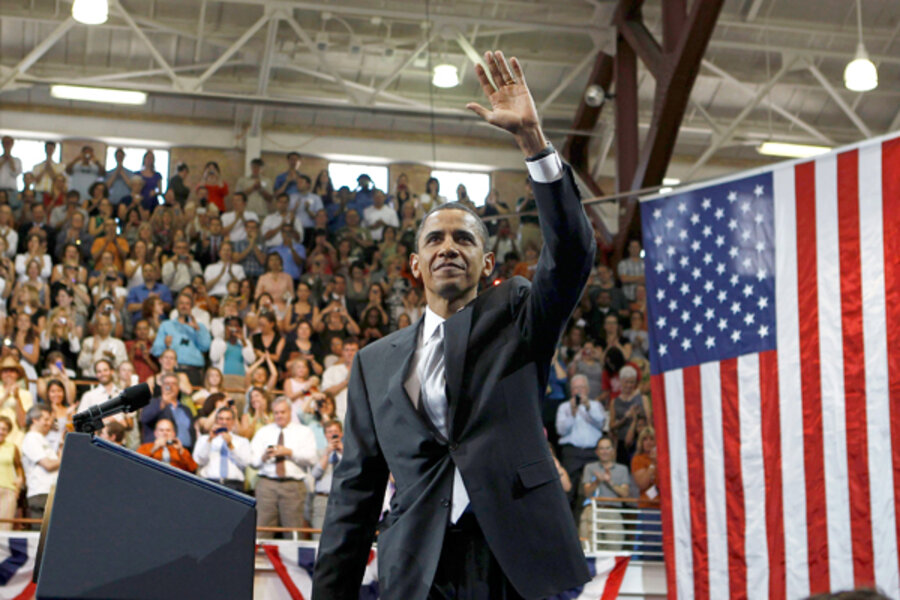Obama aims to lift college graduation rates, but his tools are few
Loading...
When President Obama spoke at the University of Texas, Austin, on Monday, he urged the United States to retake the world lead in college graduation rates by 2020. Mr. Obama highlighted the relationship between education and economic growth in his speech, saying that the future of American prosperity relies on a better-educated workforce.
But there is a key distinction between Obama’s lofty goals for America’s economy and higher education. With its economic recovery efforts, the Obama administration is trying to reestablish a long tradition of growth in the US economy. With his latest call to raise graduation rates, Obama is trying to kick-start a measurement that has “flat-lined” for decades, as Education Secretary Arne Duncan told reporters Sunday.
The US led the world in college graduation rates before falling off about a decade ago. That is still evident in the education levels of America’s oldest working citizens: According to a College Board report, 38.5 percent of Americans age 55 to 64 have at least an associate’s degree, ranking fourth in a survey of 36 developed nations.
Countries with the highest college graduation rates
Other countries have now surpassed the US among the newest crop of workers. Among today’s American 25- to 34-year olds, slightly more than 40 percent have associate’s degrees or higher, a tad higher than for their parents’ generation. But that rate places the US only 12th of the 36 countries in the College Board study.
Obama says the lower ranking is unacceptable. “We know how important an education is in the 21st century,” he said. “It is a prerequisite to prosperity."
Later, Obama added, “We know that in the coming decades, a person’s success in life will depend more and more … on a higher education.”
Obama highlighted three reasons American college graduation rates have stagnated:
- Rising costs. Tuition and housing costs rose 439 percent from 1982 to 2008, compared with a 147 percent increase in median family income (not adjusted for inflation), according to a 2008 report from the National Center for Public Policy and Higher Education.
- A disconnect between skills learned and skills needed. Obama has emphasized the role of community colleges throughout his presidency, urging (and funding) an upgrade in curriculums to teach more skills related to “the growing sectors of our economy.”
- Dropout rates. More than one-third of US college students fail to complete their degrees six years after enrollment, the president said. He proposed investment in curriculum redesigns – especially remedial programs – to help grow graduation rates from the numbers already enrolling in colleges.
However, there is only so much the federal government can do to further those goals. The feature of the president’s K-12 education policy has been the Race to the Top initiative, a $4.3 billion program that uses award funding to prompt state-level changes such as uniform national education standards, merit-based teacher pay, and the development of charter schools.
That kind of money isn’t out there for the president’s higher education plans, says Patrick Callan, president of the National Center for Public Policy and Higher Education.
“Obama had planned a pretty well-funded initiative incentivizing college completion rates, but he lost that money during the legislative process of health-care reform,” Mr. Callan says. “So he doesn’t have a lot of money, and there aren’t many ways to put more federal money in it.”
The administration won a victory in this effort earlier this year, when Congress eliminated subsidies guaranteeing student loans from private banks and instead brought federal financial aid programs in-house, freeing up the subsidy money to expand aid.
However, the government is limited in its ability to make college more affordable, too.
“They did make an important investment in financial aid, but tuition is growing far faster than financial aid,” Callan says.
Ultimately, Obama’s biggest immediate contribution to raising college graduation rates – at least while funding is nowhere to be found – may be using his bully pulpit to draw attention to the issue.
“College completion has been an Achilles' heel of American higher education for a long time,” Callan says. “That the president is calling attention to this is a big help by itself.”





